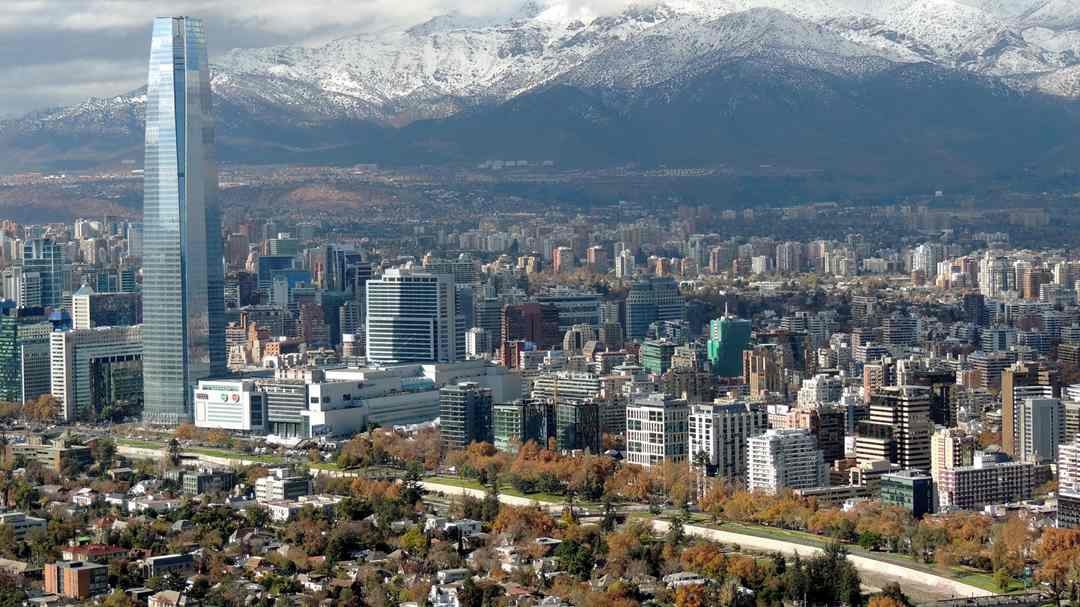Chile

Official name: Republic of Chile
Area: 756,715 square kilometers
Capital: Santiago. The city is located at 1,706 feet above sea level between the Chilean Coastal and the Andes mountains in the Chilean Central Valley. It has a population of over 200,000.
Population: 17,574,003(2017).
GDP: $298.172 billion (nominal, 2018)
GDP per capita: $16,078 (nominal, 2018 est.)
National holiday: Independence Day, 18 September (1810 from Spain)
Major language: Spanish
Major religion: Christianity
Currency: Chilean peso
President: Sebastián Piñera Echenique
Geography
Chile stretches over 4,300 km (2,670 mi) north to south, but only 350 km (217 mi) at its widest point east to west. This encompasses a remarkable variety of climates and landscapes. It contains 756,950 square kilometers (292,260 sq mi) of land area. It is situated within the Pacific Ring of Fire. Excluding its Pacific islands and Antarctic claim, Chile lies between latitudes 17°and 56°S, and longitudes 66° and 75°W.
The diverse climate of Chile ranges from the world's driest desert in the north - the Atacama Desert - through a Mediterranean climate in the center, humid subtropical in Easter Island, to an oceanic climate, including alpine tundra and glaciers in the east and south.
Economy
The Central Bank of Chile in Santiago serves as the central bank for the country. Chile is one of South America's most stable and prosperous nations, leading Latin American nations in human development, competitiveness, income per capita, globalization, economic freedom, and low perception of corruption. Since July 2013, Chile is considered by the World Bank as a "high-income economy”.
Copper mining makes up 20 percent of Chilean GDP and 60 percent of exports. Escondida is the largest copper mine in the world, producing over 5 percent of global supplies. Overall, Chile produces a third of the world's copper.
Agriculture
Agriculture in Chile encompasses a wide range of different activities due to its particular geography, climate and geology and human factors. Historically agriculture is one of the bases of Chile's economy. Now agriculture and allied sectors like forestry, logging and fishing account for only 4.9 percent of the GDP as of 2007 and employ 13.6 percent of the country's labor force. Some major agriculture products of Chile include grapes, apples, pears, onions, wheat, corn, oats, peaches, garlic, asparagus, beans, beef, poultry, wool, fish, timber and hemp.
Education
In Chile, education begins with preschool until the age of 5. Primary school is provided for children between ages 6 and 13. Students then attend secondary school until graduation at age 17.
Secondary education is divided into two parts: During the first two years, students receive a general education. Then, they choose a branch: scientific humanistic education, artistic education, or technical and professional education. Secondary school ends two years later on the acquirement of a certificate.
Health
The Ministry of Health (Minsal) is the cabinet-level administrative office in charge of planning, directing, coordinating, executing, controlling and informing the public health policies formulated by the President of Chile. The National Health Fund (Fonasa), created in 1979, is the financial entity entrusted to collect, manage and distribute state funds for health in Chile. It is funded by the public. All employees pay 7 percent of their monthly income to the fund.
Bilateral ties
Chile was the first South American country to establish diplomatic ties with China, with the year 2020 marking the 50th anniversary of the establishment of their bilateral relations.
China and Chile forged a comprehensive cooperative partnership in 2004.
In 2005, Chile became the first Latin American country to sign a free trade agreement (FTA) with China, and in 2019, it became the first country in the region to update its trade agreement China. Since the FTA took effect in 2006, more than 97 percent of Chilean goods have been able to access China's market free of tax.
In the 10 years since the Free Trade Agreement between China and Chile was signed, trade has more than tripled. Both sides have made it clear during this visit the bilateral relationship still has much more to offer.
China and Chile have already signed the inter-governmental agreement on the Belt and Road Initiative, and the next move in this regard is to define key areas and projects and strive for early harvest, said Chinese President Xi Jinping, when meeting with his Chilean counterpart Sebastian Pinera on the sidelines of the 2018 Asia-Pacific Economic Cooperation (APEC) Economic Leaders' Meeting, held in Papua New Guinea's capital city of Port Moresby.
Chile has also been a passionate client of China's environmentally-friendly electric vehicles and buses, which could modernize urban transit networks in Santiago and other major cities.


